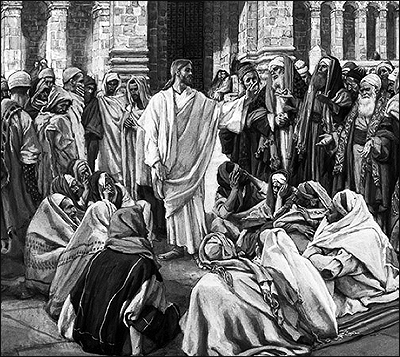
Home > Jesus > Parables of Jesus > Fasting at a Wedding Feast
 Fasting at a Wedding Feast
Fasting at a Wedding Feast
And they said to Him, “The disciples of John often fast and offer prayers, the disciples of the Pharisees also do the same, but Yours eat and drink.” 34 And Jesus said to them, “You cannot make the attendants of the bridegroom fast while the bridegroom is with them, can you? 35 But the days will come; and when the bridegroom is taken away from them, then they will fast in those days.” — Luke 5:33-35, NASB
Told in conjunction with the cloth and wineskin parables, the purpose of this parable was to show the incompatibility of the old Jewish orthodoxy with the gospel of grace. In each of the synoptic gospels it is given in response to the Pharisees trying to undermine Jesus on a legal technicality.
The Pharisees represented the de facto religious establishment in the time of Christ—hyper-legalists who created and promoted needless regulations that often exceeded the requirements of the Mosaic Law but fit neatly with their heavy emphasis on a doctrine of salvation by works. Their political influence and religious decrees allowed them to exert and maintain power over the rank and file Jewish population; not surprisingly, they regarded the ministry of Jesus and His message of salvation by grace as a threat to their authority. Throughout the gospels the Pharisees can be found on the periphery, grumbling indignantly and constantly scheming to discredit Him.
Levitical law only required fasting on the Day of Atonement, but the Pharisees self-imposed twice a week fasting as another way to set themselves apart from those they considered less obedient and righteous. Jesus and His disciples had not been observed fasting, so the Pharisees question Him on it in order to cast aspersion on His ministry.
In response, Jesus uses the illustration of a bridegroom and his attendants to represent Him and His disciples. The indication is that the bridegroom’s presence signals that a wedding feast is in progress. By definition, a wedding feast was a celebration and an obviously inappropriate venue for fasting, an activity typically associated with mourning. Jesus's presence on earth likewise meant that the Messiah had come, making fasting unnecessary among true believers. Not recognizing Jesus as the Messiah and deaf to His overall message, the Pharisees would certainly fail to get the point.
The parable is also a reminder to the disciples that He will not remain with them. There is certainly no need to fast at this festive, spiritually flush point in time because they are in the presence of God incarnate. However, the cross is coming and once Jesus is gone His followers will mourn and feel an increased need for fasting in order to draw closer to Him.
At the beginning of the passage John the Baptist's disciples are also mentioned as fasting like the Pharisees, and in Matthew’s account it is John’s disciples who question Jesus about it. By this point John had already been jailed by Herod, so his followers may have been afflicting themselves due to that, or maybe not being disciples of Jesus they had adopted some practices of the Pharisees. Because Matthew and Luke’s accounts state that they "often" fast it's most likely the latter, but the overarching point is that Jesus's message and the way He operated was at odds with the established religious practices of the day.
The idea is developed further in the parables of the cloth and the wineskins which immediately follow.
Scripture Alone • Faith Alone • Grace Alone • Christ Alone • To the Glory of God Alone
Most scripture quotations taken from the New American Standard Bible® (NASB)